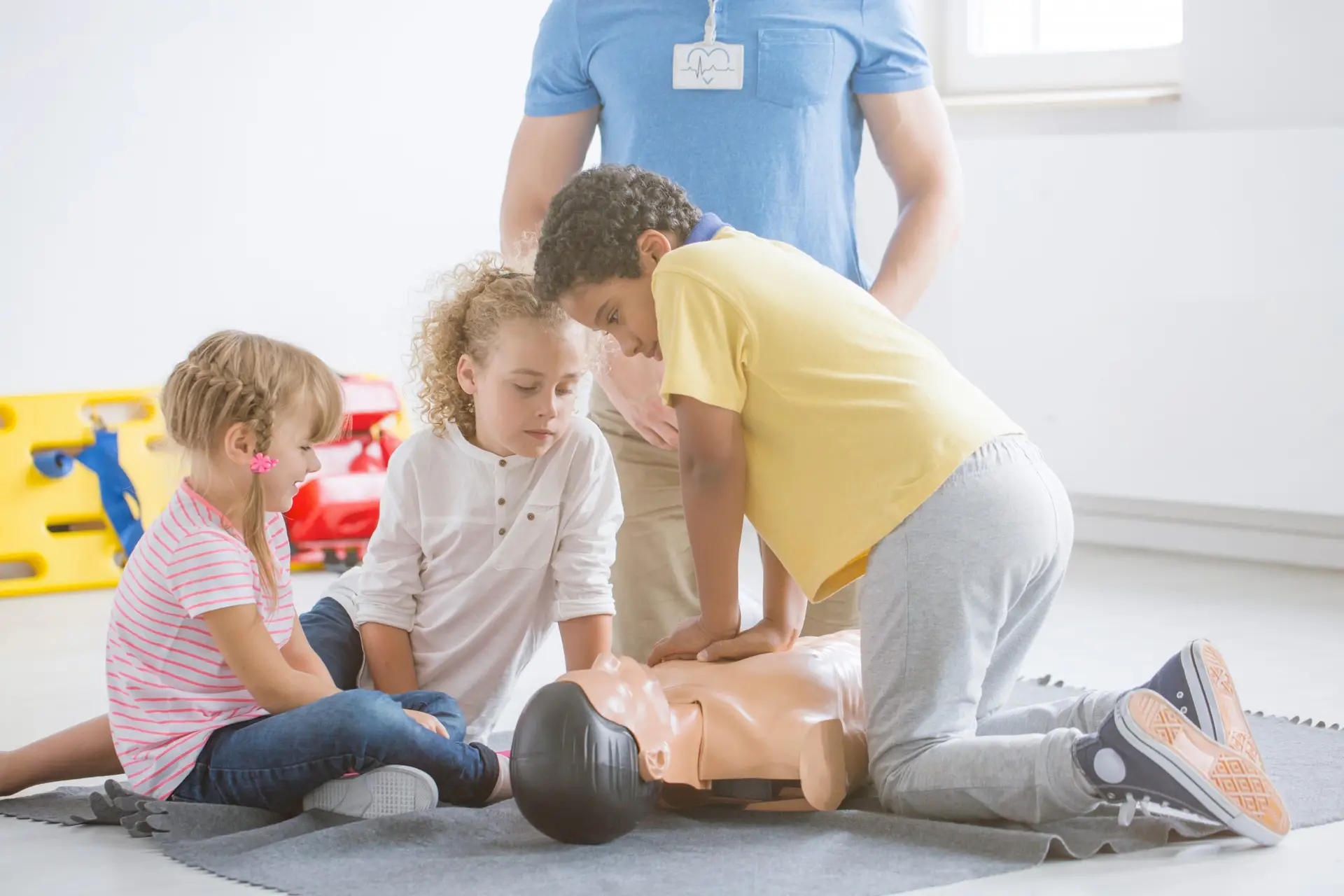When I think about CPR, it seems like a skill I’ve always known how to execute. Why? Because I learned CPR as a child—more than once!
In elementary school, middle school, at summer camp, and as a Girl Scout, I was essentially an expert in CPR training for kids. And while I’m not certified in CPR as an adult (I think I’ll change that soon!), I’ve carried the CPR steps and basics with me most of my life.
But that was quite a while ago. As times continue to change, is CPR training for kids necessary? Are kids capable of effectively administering CPR? Let’s see what the science says.
What Is CPR?
CPR—or cardiopulmonary resuscitation—is a simple emergency procedure with the potential to save lives. When someone experiences cardiac arrest—which occurs when the heart suddenly and unexpectedly stops beating—CPR can sustain their life until medical help arrives.
Indicated by shortness of breath, lightheadedness, fainting or collapse, loss of consciousness, and unresponsiveness, cardiac arrest can come on quickly. If someone collapses, doesn’t respond when shaken or spoken to, isn’t breathing normally, or lacks a pulse completely, they’ll need CPR.
Why Knowing CPR Is Important
According to the Cleveland Clinic, around 475,000 people die from cardiac arrest in the United States every year. When cardiac arrest occurs outside a medical facility, the rate of survival is incredibly low—only 10%.
However, administering CPR immediately after the onset of symptoms can double or triple someone’s chance at survival!
But fast action is critical. Every minute without CPR reduces someone’s survival rate by 7-10%. With numbers like that, the brain will already begin to die by the time medical help arrives—which can take between 8 and 12 minutes on average, as reported by The Lancet.
This is why knowing CPR is important. Whether it’s a friend, family member, or total stranger who’s suffering, just one person knowing CPR can make the difference between life and death. You can be that one person!
CPR Steps
Chest compressions are the most crucial component of CPR. They mimic a natural heartbeat, keeping the blood flowing to each of the body’s organs until the heart can get back to beating on its own.
Before beginning CPR, take these steps to assess the situation:
- Check the scene and your surroundings. Make sure it’s safe to proceed.
- Tap or nudge the person. Loudly and clearly ask if they’re okay.
- If they don’t respond, call 911. If there are bystanders, ask them to call 911 for you.
- Look and listen for normal, rhythmic breathing. Is their chest moving up and down? Can you hear or feel their breath? It’s also a good idea to check for a pulse.
- If there is no indication of independent breathing or pulse, you’ll need to begin CPR.
There are two methods you can use to administer CPR: hands-only CPR and mouth-to-mouth resuscitation. Unless you have completed CPR certification, it is recommended to perform hands-only CPR until medical help arrives.
Hands-only CPR steps:
- Make sure the person is lying on their back and on a firm, flat surface.
- Kneel next to the person. Keep your knees at shoulder width.
- Place the heel of one hand on the center of the person’s chest. Place your other hand on top, interlace your fingers, and lift them up. Keep your fingers off their chest.
- Position your shoulders directly over your hands. Lock your elbows and keep your arms straight.
- Start compressions. Push hard and fast. Compressions should be at least two inches deep and continue at a rate between 100 and 120 BPM (beats per minute).
- Allow the chest to return to normal after each compression.
- Continue steadily until medical help arrives.
Especially in an emergency, counting the rate of your compressions can be overwhelming. Instead, try administering compressions along to the beat of a song that matches the speed of 100 BPM. Popular choices include:
- “Baby Shark” by Pinkfong
- “Dancing Queen” by ABBA
- “Stayin’ Alive” by the Bee Gees
For a complete playlist of songs you can use, click here!
Should Kids Know CPR?
Absolutely! There are numerous accounts of children performing CPR correctly and saving lives.
For example, 15-year-old Eddie saved his mom’s life after she experienced cardiac arrest in their home. He administered the hands-only CPR techniques he learned years prior in his middle school health class!
Or this incredible story of 10-year-old twins who saved their dad’s life—with the help of their 11-year-old friend—after he lost consciousness underwater. They knew what to do thanks to the infamous mouth-to-mouth scene from The Sandlot!
In a study conducted by Dr. Fritz Sterz at the Medical University of Vienna, it was found that children as young as nine years old are capable of learning and retaining life support skills. While nine out of ten children could perform the procedure correctly, less than 70% effectively managed mouth-to-mouth resuscitation. Consequently, it is recommended that children focus on learning techniques for hands-only CPR—which is the same recommendation for adults without proper CPR training.
How to Teach a Child CPR
First off, you’ll need to learn the life-saving skills yourself. As an adult, you can become CPR certified in no time! Click here to find a class near you.
Generally speaking, children possess a unique zest for life and an eagerness toward learning new things. Even at a young age, children are able to retain important information for the long haul. Lessons learned young are lessons that stick with you for life!
When teaching children CPR, it’s important to simplify. While you can teach the skills as written above, it may be best to narrow it down to the essentials:
- Call 911 right away.
- Check for responsiveness and breathing.
- Push hard and fast in the center of the person’s chest. (Pick a 100-BPM song they can remember in an emergency.)
Simplifying these CPR steps makes the information even easier for a child to retain. Here’s how to teach a child CPR in other ways:
- If you’re training a group of children, the American Heart Association offers a training kit with all the equipment you need! Click here to check it out.
- Turn CPR training into a fun family activity. Take the Family & Friends CPR course through the American Heart Association!
- If you’ve got a babysitter in the house, they can learn CPR through the American Red Cross’ Babysitting & Child Care Training.
- For other CPR training materials, supplies, and equipment, you can get them here.
Children are more than capable of learning life-saving techniques like CPR. Like adults, children are able to handle and process scary and difficult situations—better than we give them credit for.


